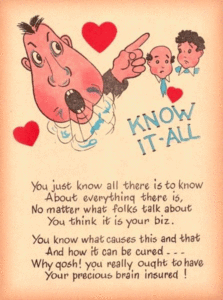
One New York publishing house in 1847 claimed it sold as many insulting cards as they did loving ones.
Vinegar valentines were cynical and insulting valentines sent, often by anonymous messengers, featuring insulting poems, caricatures and mean-spirited messages, or in a less severe form, teasing and mild jabbing.
Also known as mocking valentines, they were popular during the mid-19th century and were either tongue-in-cheek insults, rude comments or anonymous commentary on the receiver’s personality, looks or love life.
Vinegar valentine messages were usually cheap, printed on one side of a paper, and cost about one cent to buy.
Back in the days when postage was paid by the recipient, you literally paid to be insulted if you accepted a mocking valentine.
The poem or caricature is what some consider to be modern day “trolling,” insulting and putting people into scenarios and stereotypes, such as spinster, floozy, dude, scholar, etc.
Without the repercussions of saying something to someone’s face, these behind the back insults and commentary were quite popular to insult and demean in secret, with an excuse of a pun.
They were first seen in America around 1840 and manufactured by printing companies like Fisher, Elton and other big New York printing manufacturers of valentines.
Sending a mock valentine was just as popular as sending one conveying your love, and the people of the Victorian Era loved it.
The naughty cards created unflattering messages, and evoked strong emotions on all social levels.
A person who received one of these missives was often being insulted by an anonymous “admirer.”
Millions were sold right along side normal lovely valentines from the 19th and 20th centuries.
One New York publishing house in 1847 claimed it sold as many insulting cards as they did loving ones.
Sometimes postmasters would confiscate these unworthy cards and were considered unfit to be mailed.
Valentines were once a huge business and thousands were mailed during early February.
In the early 1900s, on one occasion, 25,000 valentines were held in a Chicago post office as being unfit to send, due to the rude content of the vinegary insults on the front of the card.
They were easy to read, being usually printed on just one side and without an envelope.
Some mocking valentines were full of the vinegar, and could sting and hurt the receiver on a multitude of levels going from teasing to downright cruel.
Salespeople, doctors, postmen, unmarried women, teachers and classmates were targets of these insults, just to name a few. No one was safe from a vinegar. valentine
Some warded off unwanted suitors, while others targeted people for being drinkers, or engaging in activities the sender deemed inappropriate, which could be dancing, singing, public affection or a person’s demeanor or looks. Soldiers often enjoyed sending them to their superiors, and each other, and there was a special class of mocking valentines sent to women supporting the women’s suffrage movement in the late 19th and early 20th century.
Valentine’s Day is celebrated in many ways today, with flowers, gifts and more, and paper valentines aren’t mailed like they were in those early times.
However, dear reader, watch out, you never know when someone might resurface the old custom of mocking vinegar valentines.
(Editor’s note: DeeDee Wood is the owner of Black Cat Curiosities Art and Antiques in Easton, Md., located at 24B Harrison St.)



